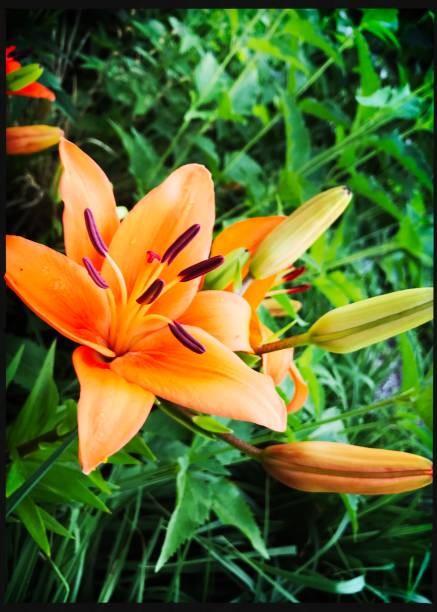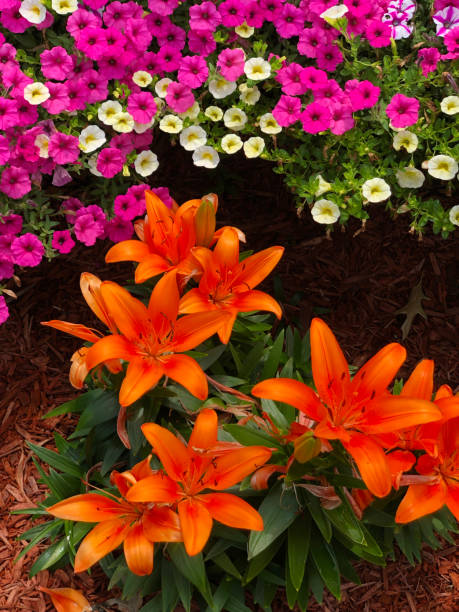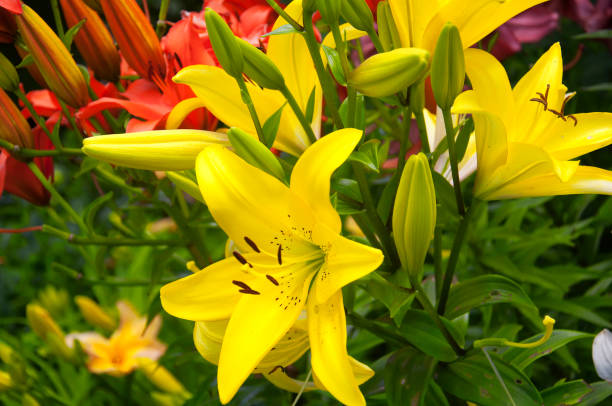Why Are My Lilies Not Blooming?
Lilies are one of the well-known flowers in the world. They can be found in almost any garden and are often used in wedding bouquets. However, despite having regular water and fertilizer, some lilies are not blooming. The reasons maybe related to bulb size and quality, overcrowding, planted too shallow, and lack of sunlight. After all, it’s better to address the problem early than let it worsen and cause more damage.
Table of Contents
Factors Why Lilies Aren’t Blooming

Bulb Size and Quality
If your lilies haven’t bloomed for a year or so, it may be because the bulb is too big and mature. It takes a lot of energy to flower, and small bulbs often lack these resources in their first year of growth.
As a result, they put less effort into displaying flowers and more into growing and establishing themselves in the new soil. The next year’s flowering is more likely as the bulb develops and matures. Lilies with flowers are more likely to come from larger, more mature bulbs because they have more energy available for the plant to bloom in Spring.
Lilies and other flowering plants need to select the largest and healthiest looking bulbs possible to ensure a healthy plant and a beautiful display of flowers after planting.
Bulb Overcrowding
Some lilies don’t flower because the bulbs are too close together. There’s a lot of competition between the bulbs when the green leaves start to grow in Spring. They compete for space, nutrients, moisture, and sunlight when the leaves start to grow.
The best way to deal with this is to dig up the bulbs and plant them at a more appropriate distance so that each lily can get the resources it needs to flower. Place each bulb at least eight inches apart. A good way to make sure the lilies are close together and have enough space to grow is to make sure they are close enough together.
We should dig up our lilies if they aren’t flowering, and we know they are too close together. We should do this in the fall to have time to adapt and start blooming in Spring.
Planting of Lily Bulbs Too Shallow
Flowering can be affected by the depth of your lily bulbs. Bulbs can be damaged by frost if they are planted too shallowly, while it is possible for bulbs to be damaged if they are planted too deep. Lily bulbs should be planted at a depth of four times the diameter of each bulb. As a result, the bulb can thrive through the winter and Spring.
Lilies Need a Lot of Sunlight to Bloom
Most lilies like to be in the sun for about six or more hours a day to show off their flowers. When the lily gets a lot of sun, it can get the energy it needs to make flowers. When the lily receives a lot of sun, it can get the energy to make flowers. Make sure that the lilies in your garden get enough light by cutting back any overhanging tree limbs or foliage near them.
As a last resort, you can wait until the fall when the lilies have died back and dig up their bulbs to move them to a more sunny area of the garden. It would help if you did not move the lilies in the Spring or Summer because it can cause them to get hurt when they move.
In a sunny place, your lilies have more energy, leading to a lot of flowers. There is a greater chance of drought in full sun, so mulch the ground around the lilies with compost.

Cold Winters Are Necessary for Lily Flower Displays
The Asiatic lily, one of the most common lilies, requires a cold period in the winter to bloom in the Spring (a process known as vernalization). Due to a seasonal temperature change, the bulb can know when it should grow and produce flowers in the Spring.
Asian lilies are adapted to temperate climates, so if you try to grow them in a hot climate instead of a cool one, the winters may not be cold enough for them to go through the vernalization process. As a result, the plant may not thrive and will likely never flower.
In order to get the most out of your Asiatic lily bulbs, if you live in an area where the winters are mild rather than cold, it is best to select the appropriate lily species for your climate. Because the Easter lilies species does not require vernalization in hot climates, it’s a more reliable lily for flowering.
Too Much Nitrogen
Lilies like to grow in soil with many nutrients, and they often don’t need extra fertilizer to grow and flower. Too much fertilizer, especially if it is high in Nitrogen, can make a plant have a lot of green foliage but not many flowers, especially if it is applied before the plant is ready to flower in the early Spring. A lily that has been given fertilizer can’t be encouraged to flower by giving it less fertilizer or waiting for the next year to come around.
Fertilizer can be good for lilies in poor soil or potting soil where the nutrients have run out. This can help them grow. All-purpose fertilizer with 10:10:10 NPK or tomato fertilizer, which is high in potassium, is a good choice for lilies after they have finished blooming.
Removing Lily Leaves Too Soon Reduces Next Year’s Flowers
Some gardeners prefer to remove the lily’s foliage after it has flowered rather than waiting for the leaves to turn yellow in the fall to maintain a neat formal garden. However, if you cut away the leaves after they have bloomed, they will be unable to store energy for the following spring and will not produce flowers.
After flowering, the lily’s leaves are still alive and well, and they spend the rest of the summer and fall absorbing nutrients and gaining energy from the sun, which they then use to fuel the plant’s growth and display of flowers following year.
To encourage the lilies to flower, it is a great method to wait until the leaves turn yellow or brown before removing the foliage at the end of the season.
Drought
Water balance is essential for lilies, which means that the soil must be consistently moist but not wet or sloppy.
For example, if the soil is slow to drain (due to clay soil or boggy areas), the bulbs of your lilies may rot in the ground, particularly during the winter months.
When soil is too dry, however, the bulbs will not grow and flower because they will lack the moisture they need to thrive.
There are reasons why soil can be too dry for lilies.
- sandy soil with excellent drainage that drains quickly and does not retain any moisture
- Excessive exposure to direct sunlight on the soil dries it out.
- When it comes to moisture, tree roots compete with bulbs.
- Planting lilies in soil that have been amended with compost or leaf mold will ensure that they flower successfully and have the best moisture balance possible.
Even though compost and leaf mold can hold moisture, their porous structure still allows excess water to drain away from the bulbs, preventing them from being sat in saturated soil, which is the ideal growing environment for growing lilies. When applied in the Spring around the lilies, compost mulch can help retain moisture while also improving the soil’s nutrient profile and structure, ensuring that the lilies are not affected by drought.
Give the soil a good soak. Probe the soil to a depth of a few fingers to see any moisture. Suppose the soil is beginning to dry out. Water the ground. However, if the soil is still moist and the mulch effectively retains moisture, you will not need to water the ground further.
Flowers should bloom well the following year if the soil has consistent moisture (but not too much water, as this will result in the bulbs of the lily bulbs rotting).
Why Are My Lilies Not Blooming?
Lilies are one of the well-known flowers in the world. They can be found in almost any garden and are often used in wedding bouquets. However, despite having regular water and fertilizer, some lilies are not blooming. If you’re one of these unlucky ones, don’t worry! This guide will help you know the reasons why and troubleshoot the issue. After all, it’s better to address the problem early than let it worsen and cause more damage.

Factors Why Lilies Aren’t Blooming
Bulb Size and Quality
If your lilies haven’t bloomed for a year or so, it may be because the bulb is too big and mature. It takes a lot of energy to flower, and small bulbs often lack these resources in their first year of growth.
As a result, they put less effort into displaying flowers and more into growing and establishing themselves in the new soil. The next year’s flowering is more likely as the bulb develops and matures. Lilies with flowers are more likely to come from larger, more mature bulbs because they have more energy available for the plant to bloom in Spring.
Lilies and other flowering plants need to select the largest and healthiest looking bulbs possible to ensure a healthy plant and a beautiful display of flowers after planting.
Bulb Overcrowding
Some lilies don’t flower because the bulbs are too close together. There’s a lot of competition between the bulbs when the green leaves start to grow in Spring. They compete for space, nutrients, moisture, and sunlight when the leaves start to grow.
The best way to deal with this is to dig up the bulbs and plant them at a more appropriate distance so that each lily can get the resources it needs to flower. Place each bulb at least eight inches apart. A good way to make sure the lilies are close together and have enough space to grow is to make sure they are close enough together.
We should dig up our lilies if they aren’t flowering, and we know they are too close together. We should do this in the fall to have time to adapt and start blooming in Spring.
Planting of Lily Bulbs Too Shallow
Flowering can be affected by the depth of your lily bulbs. Bulbs can be damaged by frost if they are planted too shallowly, while it is possible for bulbs to be damaged if they are planted too deep. Lily bulbs should be planted at a depth of four times the diameter of each bulb. As a result, the bulb can thrive through the winter and Spring.
Lilies Need a Lot of Sunlight to Bloom
Most lilies like to be in the sun for about six or more hours a day to show off their flowers. When the lily gets a lot of sun, it can get the energy it needs to make flowers. When the lily receives a lot of sun, it can get the energy to make flowers. Make sure that the lilies in your garden get enough light by cutting back any overhanging tree limbs or foliage near them.
As a last resort, you can wait until the fall when the lilies have died back and dig up their bulbs to move them to a more sunny area of the garden. It would help if you did not move the lilies in the Spring or Summer because it can cause them to get hurt when they move.
In a sunny place, your lilies have more energy, leading to a lot of flowers. There is a greater chance of drought in full sun, so mulch the ground around the lilies with compost.
Cold Winters Are Necessary for Lily Flower Displays
The Asiatic lily, one of the most common lilies, requires a cold period in the winter to bloom in the Spring (a process known as vernalization). Due to a seasonal temperature change, the bulb can know when it should grow and produce flowers in the Spring.
Asian lilies are adapted to temperate climates, so if you try to grow them in a hot climate instead of a cool one, the winters may not be cold enough for them to go through the vernalization process. As a result, the plant may not thrive and will likely never flower.
In order to get the most out of your Asiatic lily bulbs, if you live in an area where the winters are mild rather than cold, it is best to select the appropriate lily species for your climate. Because the Easter lilies species does not require vernalization in hot climates, it’s a more reliable lily for flowering.
Too Much Nitrogen
Lilies like to grow in soil with many nutrients, and they often don’t need extra fertilizer to grow and flower. Too much fertilizer, especially if it is high in Nitrogen, can make a plant have a lot of green foliage but not many flowers, especially if it is applied before the plant is ready to flower in the early Spring. A lily that has been given fertilizer can’t be encouraged to flower by giving it less fertilizer or waiting for the next year to come around.
Fertilizer can be good for lilies in poor soil or potting soil where the nutrients have run out. This can help them grow. All-purpose fertilizer with 10:10:10 NPK or tomato fertilizer, which is high in potassium, is a good choice for lilies after they have finished blooming.
Removing Lily Leaves Too Soon Reduces Next Year’s Flowers
Some gardeners prefer to remove the lily’s foliage after it has flowered rather than waiting for the leaves to turn yellow in the fall to maintain a neat formal garden. However, if you cut away the leaves after they have bloomed, they will be unable to store energy for the following spring and will not produce flowers.
After flowering, the lily’s leaves are still alive and well, and they spend the rest of the summer and fall absorbing nutrients and gaining energy from the sun, which they then use to fuel the plant’s growth and display of flowers following year.
To encourage the lilies to flower, it is a great method to wait until the leaves turn yellow or brown before removing the foliage at the end of the season.
Drought
Water balance is essential for lilies, which means that the soil must be consistently moist but not wet or sloppy.
For example, if the soil is slow to drain (due to clay soil or boggy areas), the bulbs of your lilies may rot in the ground, particularly during the winter months.
When soil is too dry, however, the bulbs will not grow and flower because they will lack the moisture they need to thrive.
There are reasons why soil can be too dry for lilies.
- sandy soil with excellent drainage that drains quickly and does not retain any moisture
- Excessive exposure to direct sunlight on the soil dries it out.
- When it comes to moisture, tree roots compete with bulbs.
- Planting lilies in soil that have been amended with compost or leaf mold will ensure that they flower successfully and have the best moisture balance possible.
Even though compost and leaf mold can hold moisture, their porous structure still allows excess water to drain away from the bulbs, preventing them from being sat in saturated soil, which is the ideal growing environment for growing lilies. When applied in the Spring around the lilies, compost mulch can help retain moisture while also improving the soil’s nutrient profile and structure, ensuring that the lilies are not affected by drought.
Give the soil a good soak. Probe the soil to a depth of a few fingers to see any moisture. Suppose the soil is beginning to dry out. Water the ground. However, if the soil is still moist and the mulch effectively retains moisture, you will not need to water the ground further.
Flowers should bloom well the following year if the soil has consistent moisture (but not too much water, as this will result in the bulbs of the lily bulbs rotting).
